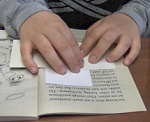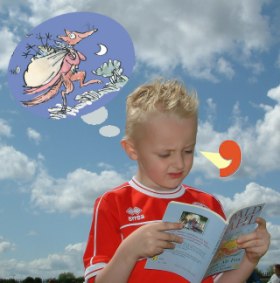The Value of Picture-at-Punctuation
A tool to improve oral communication skills as well as reading comprehension
“Picture at Punctuation” is a multi-faceted tool that builds many dyslexic weaknesses into strengths if it becomes a habit by being practiced every day for the first 30 days after a Davis program. It is the third and final tool introduced as part of Davis’ “Three Steps to Easier Reading.” — but it offers much more to students than merely improving reading skills.
The tool begins with a mental picture that is formed by the reader whenever encountering punctuation in print. The key is to take the words, stopping at the end of each thought, segment, or sentence, and translate them into the pictures the dyslexic mind processes and retains. It can be used effectively with spoken as well as written words.
The picture can be very simple. It needs to depict every important thing in the sentence or clause, and it should not have anything that doesn’t belong. Just as with the clay models formed in Davis Symbol Mastery, it should be “as simple as possible, as complex as necessary”.
This process teaches the dyslexic and builds in the reader the ability to harness the imagination and limit it to what the writer intended. If the author didn’t mention a dog, but that dog is “necessary” to the reader in order to picture the “comfy home” the author did mention, the reader may picture it until it becomes confusing and a detriment to comprehension/retention — but recognize the author didn’t place the dog there, the reader did. The purpose of writing is to pass the thoughts of the writer across time and space — it is the responsibility of the picture thinking reader to get the writer’s intention/inflection by limiting his picture to what is written and properly using the punctuation to gain intention/voice inflection.
When a reader/listener adds too much to the picture, the intention of the written/spoken word is lost as the reader “writes” his or her own story or instructions. Likewise, when a dyslexic reader/listener cannot picture something, it doesn’t exist for him or her and is not included in the retained picture.
Forming pictures helps with oral expression and the ability to listen and follow instructions.
Making Picture-at-Punctuation a habit or part of the thinking process provides the individual with more than merely comprehending and retaining the word. Picture Thinkers tend to have difficulty expressing themselves to others who are not picture thinkers; that is, it can be difficult to put their thoughts into words. The daily practice of orally doing Picture-at-Punctuation every day for ten minutes with a parent or other helper will necessarily require the picture thinker to become a “Picture Describer” and build the ability to express oneself by describing those pictures in the mind.
Moving forward to individuals who express difficulty completing a list of tasks given in a set of oral instructions, Picture-at-Punctuation is a key that allows the person to see where the breakdown exists in the ability to complete those instructions. Usually there is a part of the instructions for which the listener has no picture. Alternately once the first task is listed, the dyslexic listener “turns off” orientation and totally misses the following instructions, thus failing to picture them.
When I work with a client who has expressed as a goal completing a list of instructions, we practice this every session after Picture-at-Punctuation is acquired. Here’s how:
My office is in my home and my clients have access to all public areas, so I instruct from the office to the bathroom, to the kitchen, to the living and dining rooms, etc., always four or more instructions. The client’s job is to listen, ask any questions before starting, and complete every instruction as instructed.
After a couple of successes, I put an orange “squeeter” (a plastic kitchen gadget with which the client is probably not familiar) and another gadget (a plastic banana slicer) underneath a kitchen chair when the client is unaware. My next set of instructions will be: “Go into the living room and play three notes on the piano, go into the bathroom and wash your hands and dry them with a paper towel, bring the paper towel into this office and place it in this trash can, and then get the squeeter from the floor under the kitchen table and bring it back, put it on this table and sit down.”
This is actually eleven instructions, but is perceived as four multifaceted. If the client doesn’t ask what a “squeeter” is before embarking on the list, I sit in anticipation as the other tasks are performed. I know there will be a confusion when the eyes travel beneath the kitchen table because there was no picture and there is no certainty of what to do with two unknown things from which to choose.
Some tips for learning how to create a mental picture.
As to how to create a picture, I suggest picturing name tags or name jewelry when an animal or person’s name is noted in a sentence. Someone remembering, thinking or repeating what another person has said should be in a thought or dream “balloon” (as we do with Symbol Mastery). Merely orally repeating the written word is not sufficient — a description of the picture is necessary. “Mom opened the bedroom door and she was angry” cannot be described as “mom is at the door and she’s angry” or I will say, “How does that look?” until “Suzie’s mother is between the door and the doorjamb of Susie’s bedroom and she’s frowning with flashing eyes and scrunched eyebrows,” or some other picture of an angry woman in the doorway, with clues she is mom and it is a bedroom door.
With my support training, I suggest that parents ask the questions, “How does that look?” or “What would that look like?”. The the more accurate and complete the picture, the better the comprehension and retention.
Doing Symbol Mastery on every trigger word is vital and will remove the “boulders” from the reading road, making reading progress smoother, but incorporating Picture-at-Punctuation will give satisfaction in every area of the picture-thinker’s life.
The better and more imbedded Picture-at-Punctuation is into a picture thinker’s life, the easier it will be to read and accurately answer questions, to follow a lecture and retain the content, to successfully follow instructions, and to express oneself to others. While the other Davis Tools provide structure and control, I think Picture-at-Punctuation is the gloss on the program that will make it shiny and beautiful the remainder of a dyslexic person’s life — in every endeavor — and will establish those other tools better as it is practiced faithfully.
Thanks, Ron Davis, for sharing your inventions and discoveries so we can so enrich the lives of others!

Nancy Louk Kress
Nancy Louk Kress has offered her services as licensed Davis Facilitator in central Arizona since 2001. For more information about her practice, visit her web site at www.dyslexiacorrector.com.
Related Article

Davis Reading Exercises: Spell Reading & Sweep-Sweep-Spell
Building Skills for Visual Word Recognition Davis Spell-Reading and Sweep-Sweep-Spell are important because they build a vital center for reading in the brain. Beginning readers often rely exclusively on phonetic decoding strategies for all words, a process usually centered in […]


